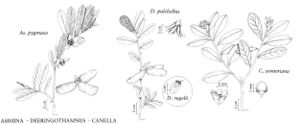Difference between revisions of "Canellaceae"
FNA>Volume Importer |
imported>Volume Importer |
||
| (7 intermediate revisions by 2 users not shown) | |||
| Line 13: | Line 13: | ||
}}<!-- | }}<!-- | ||
| − | --><span class="statement" id="st- | + | --><span class="statement" id="st-undefined" data-properties=""><b>Trees </b>[or prostrate shrubs], evergreen, aromatic. <b>Pith</b> homogeneous. <b>Leaves</b> alternate, simple, without stipules; petiole short. <b>Leaf</b> blade pinnately veined, unlobed, margins entire; pellucid dots (oil cells in tissue of leaf) conspicuous or inconspicuous. <b>Inflorescences</b> terminal and axillary, cymes [racemes or solitary flowers], pedunculate; bracts present or absent. <b>Flowers</b> bisexual; perianth hypogynous, segments imbricate; sepals persistent, 3; petals 5[-12] in 1[-4] whorl(s); stamens [7-]10[-12], hypogynous, monadelphous; filaments connate, forming tube around pistil; anthers extrorse, longitudinally dehiscent; pistil 1, superior, 2-6-carpellate; ovary 1-locular; placentation parietal, placentas 2[-6]; ovules 2-3 per placenta; style 1, generally short; stigma 1, usually 2-6-lobed. <b>Fruits</b> berries. <b>Seeds</b> 2 or more, not arillate; endosperm oily [ruminate].</span><!-- |
-->{{Treatment/Body | -->{{Treatment/Body | ||
| − | |distribution=Primarily tropical;Western Hemisphere;Africa (including Madagascar) | + | |distribution=Primarily tropical;Western Hemisphere;Africa (including Madagascar). |
|discussion=<p>Genera 6, species ca. 20 (1 genus, 1 species in the flora).</p><!-- | |discussion=<p>Genera 6, species ca. 20 (1 genus, 1 species in the flora).</p><!-- | ||
--><p>The family was placed in Hypericales by J. K. Small (1933); the combination of oil cells in most of the tissue, pollen with a single distal furrow (occasionally with 3-radiate surficial furrow), very long vessels, and scalariform vessel perforation plates with many bars suggests Magnoliales or Annonales (A. Cronquist 1981; R. M. T. Dahlgren 1980; H. Melchoir and W. Schultze-Motel 1959; R. F. Thorne 1976; T. K. Wilson 1960; C. E. Wood Jr. 1958). Further support of this placement comes from leaf architecture studies by L. J. Hickey (1971) and P-type plastids in sieve elements (H. -D. Behnke 1988).</p> | --><p>The family was placed in Hypericales by J. K. Small (1933); the combination of oil cells in most of the tissue, pollen with a single distal furrow (occasionally with 3-radiate surficial furrow), very long vessels, and scalariform vessel perforation plates with many bars suggests Magnoliales or Annonales (A. Cronquist 1981; R. M. T. Dahlgren 1980; H. Melchoir and W. Schultze-Motel 1959; R. F. Thorne 1976; T. K. Wilson 1960; C. E. Wood Jr. 1958). Further support of this placement comes from leaf architecture studies by L. J. Hickey (1971) and P-type plastids in sieve elements (H. -D. Behnke 1988).</p> | ||
| Line 59: | Line 59: | ||
|family=Canellaceae | |family=Canellaceae | ||
|illustrator=John Myers | |illustrator=John Myers | ||
| − | |distribution=Primarily tropical;Western Hemisphere;Africa (including Madagascar) | + | |illustration copyright=Flora of North America Association |
| + | |distribution=Primarily tropical;Western Hemisphere;Africa (including Madagascar). | ||
|reference=behnke1988a;correll1982a;dahlgren1980a;gilg1925a;melchior1959a;tomlinson1980a;wilson1960a;wood1958c | |reference=behnke1988a;correll1982a;dahlgren1980a;gilg1925a;melchior1959a;tomlinson1980a;wilson1960a;wood1958c | ||
|publication title= | |publication title= | ||
|publication year= | |publication year= | ||
|special status= | |special status= | ||
| − | |source xml=https:// | + | |source xml=https://bitbucket.org/aafc-mbb/fna-data-curation/src/2e0870ddd59836b60bcf96646a41e87ea5a5943a/coarse_grained_fna_xml/V3/V3_889.xml |
| − | |||
| − | |||
| − | |||
| − | |||
| − | |||
| − | |||
| − | |||
| − | |||
| − | |||
| − | |||
| − | |||
| − | |||
| − | |||
| − | |||
| − | |||
| − | |||
| − | |||
| − | |||
| − | |||
| − | |||
| − | |||
| − | |||
| − | |||
| − | |||
| − | |||
| − | |||
| − | |||
| − | |||
| − | |||
| − | |||
| − | |||
| − | |||
| − | |||
| − | |||
| − | |||
| − | |||
| − | |||
| − | |||
| − | |||
| − | |||
| − | |||
| − | |||
| − | |||
| − | |||
| − | |||
}}<!-- | }}<!-- | ||
-->[[Category:Treatment]] | -->[[Category:Treatment]] | ||
Latest revision as of 21:52, 5 November 2020
Trees [or prostrate shrubs], evergreen, aromatic. Pith homogeneous. Leaves alternate, simple, without stipules; petiole short. Leaf blade pinnately veined, unlobed, margins entire; pellucid dots (oil cells in tissue of leaf) conspicuous or inconspicuous. Inflorescences terminal and axillary, cymes [racemes or solitary flowers], pedunculate; bracts present or absent. Flowers bisexual; perianth hypogynous, segments imbricate; sepals persistent, 3; petals 5[-12] in 1[-4] whorl(s); stamens [7-]10[-12], hypogynous, monadelphous; filaments connate, forming tube around pistil; anthers extrorse, longitudinally dehiscent; pistil 1, superior, 2-6-carpellate; ovary 1-locular; placentation parietal, placentas 2[-6]; ovules 2-3 per placenta; style 1, generally short; stigma 1, usually 2-6-lobed. Fruits berries. Seeds 2 or more, not arillate; endosperm oily [ruminate].
Distribution
Primarily tropical, Western Hemisphere, Africa (including Madagascar).
Discussion
Genera 6, species ca. 20 (1 genus, 1 species in the flora).
The family was placed in Hypericales by J. K. Small (1933); the combination of oil cells in most of the tissue, pollen with a single distal furrow (occasionally with 3-radiate surficial furrow), very long vessels, and scalariform vessel perforation plates with many bars suggests Magnoliales or Annonales (A. Cronquist 1981; R. M. T. Dahlgren 1980; H. Melchoir and W. Schultze-Motel 1959; R. F. Thorne 1976; T. K. Wilson 1960; C. E. Wood Jr. 1958). Further support of this placement comes from leaf architecture studies by L. J. Hickey (1971) and P-type plastids in sieve elements (H. -D. Behnke 1988).
